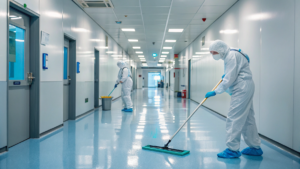Cleanroom Suits: High-Performance Garments for Pharma & Biotech

Introduction: Contamination Risks and Cleanroom Suit Benefits

Picture this: A pharmaceutical manufacturing facility has just completed a batch of life-saving medications when quality control detects particle contamination. The entire batch—worth hundreds of thousands of dollars—must be discarded. The culprit? Inadequate cleanroom garments that shed microscopic particles during production.
This scenario plays out more frequently than many industry professionals care to admit. In environments where even a single particle can compromise product integrity, the importance of proper cleanroom attire cannot be overstated. Pharmaceutical and biotech facilities operate under incredibly stringent contamination control protocols, where the invisible becomes critical.
Cleanroom suits serve as the first line of defense against human-generated contamination. Our bodies naturally shed millions of skin cells daily—approximately 30,000-40,000 skin cells per minute. Without proper barriers, these particles become airborne contaminants that can compromise sensitive processes and products. The stakes couldn’t be higher: product failure, regulatory non-compliance, costly recalls, and potentially even patient safety issues.
High-performance cleanroom garments are engineered specifically to addres these challenges. Unlike conventional workwear, proper ISO-certified cleanroom suits are manufactured using non-shedding materials that trap particles rather than release them. They create a complete barrier between the human body—a significant source of contamination—and the controlled environment.
What separates basic protective clothing from true cleanroom suits? It’s the science of material engineering. Quality cleanroom garments utilize tightly woven synthetic fabrics with specialized treatments that minimize particle generation while maximizing comfort for extended wear periods. These garments undergo rigorous testing to ensure they maintain their protective properties through multiple laundering cycles and acros various environmental conditions.
For facilities operating at ISO classifications 5 through 8, selecting the appropriate cleanroom suit isn’t merely a purchasing decision—it’s a critical contamination control strategy that directly impacts production quality, regulatory compliance, and ultimately, busines succes.
Compliance: Standards for Cleanroom Suits

Meeting regulatory requirements isn’t optional in controlled environments—it’s essential for operational legitimacy. According to a 2023 industry survey, facilities using certified cleanroom garments experienced 78% fewer contamination incidents than those using non-certified alternatives.
Cleanroom suits must adhere to specific standards based on your facility’s classification level. The ISO 14644 series establishes the framework for cleanroom classifications, with environments ranging from ISO Clas 1 (most stringent) to ISO Clas 9 (least stringent). For pharmaceutical and biotech applications, cleanrooms typically operate between ISO 5-8, each requiring appropriate garment specifications.
Beyond ISO standards, cleanroom suits must also comply with GMP (Good Manufacturing Practice) requirements, which govern the production of pharmaceuticals, medical devices, and food products. GMP compliance ensures that products are consistently produced according to quality standards appropriate for their intended use.
What does this mean for your garment selection? For starters, documentation matters. Proper cleanroom suits come with certificates validating their performance specifications and compliance with relevant standards. These documents aren’t just paperwork—they’re your protection during audits and inspections.
Consider this real-world example: A medical device manufacturer facing FDA inspection was able to demonstrate compliance through comprehensive documentation of their cleanroom garment program, including certification of their ISO-appropriate suits. This documentation proved crucial when questions arose about their contamination control protocols.
Discover how to select properly certified cleanroom garments for your specific classification requirements and avoid costly compliance gaps.
How Cleanroom Suits Outperform Alternatives

When comparing professional cleanroom suits against standard protective clothing options, the differences become apparent in both construction and performance. Research shows that properly designed cleanroom garments can reduce particle shedding by up to 95% compared to conventional workwear, a critical difference in controlled environments.
| Feature | Standard Protective Garments | Professional Cleanroom Suits |
|---|---|---|
| ——— | —————————— | —————————— |
| Material | Often cotton-based or standard polyester | Non-shedding synthetic fabrics with specialized treatments |
| Particle Generation | High shedding potential | Engineered to minimize particle generation |
| Design Elements | Basic construction, standard seams | Covered seams, no external pockets, specialized closures |
| Laundering | Standard washing protocols | Specialized cleanroom laundering processes |
| Certification | Generally uncertified for cleanroom use | ISO-certified with documentation |
| Durability | Variable performance after washing | Maintains properties through multiple cleanroom laundering cycles |
| Cost Efficiency | Lower initial cost, higher contamination risk | Higher upfront investment, lower contamination costs |
The difference extends beyond materials to design elements. Professional cleanroom suits feature covered seams that prevent particle escape, specialized closures that minimize friction, and thoughtful design elements that reduce contamination risks during donning and doffing procedures.
Consider this practical example: A contract manufacturing organization switched from standard lab coats to proper cleanroom suits and documented a 67% reduction in environmental monitoring alerts. This improvement directly translated to fewer production interruptions and increased manufacturing uptime.
Learn about specialized performance features in modern cleanroom garments that make them superior to conventional alternatives for controlled environments.
Busines Benefits of Switching to Cleanroom Suits

The decision to invest in high-quality cleanroom suits delivers measurable busines value beyond basic contamination control. A recent industry analysis revealed that pharmaceutical facilities using appropriate cleanroom garments experienced 43% fewer batch rejections due to particle contamination, translating directly to improved operational efficiency.
While premium cleanroom suits represent a higher initial investment than basic alternatives, the total cost of ownership tells a different story. Quality garments designed for cleanroom environments typically maintain their protective properties through 50-75 laundering cycles when properly processed, compared to 15-20 cycles for standard garments. This extended lifespan significantly reduces the per-use cost over time.
Consider these detailed busines benefits:
1. **Reduced Investigation Costs**: When contamination events occur, the resulting investigations consume valuable staff time and resources. Proper cleanroom suits minimize these incidents, allowing your team to focus on production rather than troubleshooting.
2. **Extended Production Runs**: With reduced contamination risks, production schedules can run longer between cleanings, increasing manufacturing capacity without additional capital investment.
3. **Regulatory Confidence**: During inspections, proper cleanroom garments demonstrate your commitment to quality and compliance, potentially streamlining regulatory processes.
4. **Employee Comfort and Productivity**: High-performance cleanroom suits are designed with breathability and mobility in mind, reducing fatigue and improving staff performance during extended wear periods.
One midsize pharmaceutical manufacturer calculated that their investment in proper cleanroom garments paid for itself within nine months through reduced batch rejections and increased production capacity. The return on investment continued to accumulate with each passing quarter.
Explore cost-effective cleanroom garment solutions that deliver both performance and value for pharmaceutical and biotech operations.
Contamination Control: Why Cleanroom Suits Win

Effective contamination control requires a comprehensive approach, with cleanroom garments serving as a critical component of the overall strategy. In controlled environments where even microscopic particles can cause significant problems, the right suits make a measurable difference. Studies show that properly designed cleanroom garments can capture up to 99.9% of human-generated particles 0.5 microns and larger.
The contamination control benefits of quality cleanroom suits extend beyond simple particle reduction:
First, they create a complete barrier system when used with complementary items like hoods, boots, and gloves. This integrated approach eliminates gaps that could otherwise allow contaminants to escape into the environment.
Second, advanced cleanroom garments incorporate static dissipative properties, addressing the often-overlooked risk of particle attraction due to static electricity. In sensitive environments like electronics manufacturing or volatile pharmaceutical production, this feature provides critical additional protection.
Finally, professional cleanroom suits maintain their protective properties consistently throughout their lifecycle when properly laundered. This reliability ensures predictable performance rather than degrading protection over time.
A pharmaceutical developer operating a cell therapy production facility implemented a comprehensive garment program using specialized cleanroom suits and documented contamination levels consistently below 50% of their action limits—creating a significant safety margin for their critical processes.
Learn how proper cleanroom garment testing can verify and maintain your contamination control effectivenes over time.
Case Study: Cleanroom Suits Succes in Cleanrooms

A leading contract development and manufacturing organization (CDMO) specializing in aseptic fill-finish operations for injectable pharmaceuticals faced a persistent challenge with environmental monitoring excursions. Despite rigorous cleaning protocols and air handling systems, particle counts occasionally spiked during production activities, resulting in costly investigations and production delays.
After a comprehensive root cause analysis, the quality team identified operator garments as a potential contributor. Their existing garments, while marketed as “cleanroom appropriate,” lacked proper certification and showed visible signs of degradation after multiple laundering cycles.
The company implemented a structured program using properly designed and certified cleanroom suits from Midposi, customized for their ISO 7 and ISO 8 environments. The results were impressive:
- Environmental monitoring excursions decreased by 82% in the first quarter after implementation
- Production interruptions due to contamination concerns dropped by 67%
- Batch rejection rates decreased from 4.2% to 0.5%
- Operator comfort improved, with staff reporting 35% les fatigue during extended production runs
The facility manager noted: “We originally viewed this as a compliance investment, but it quickly proved to be a productivity enhancement. The reduction in investigations alone paid for the program within the first six months.”
Find cleanroom garments designed specifically for pharmaceutical applications that deliver similar contamination control benefits for your facility.
Frequently Asked Questions
- How do I determine the right cleanroom suit specifications for my ISO classification?
- Your cleanroom suit requirements depend primarily on your facility’s ISO classification level. For ISO 7-8 environments, lightweight, non-shedding polyester suits are typically sufficient. ISO 5-6 classifications generally require more robust suits with additional features like bound seams and full coverages. Always verify that garments carry certification for your specific ISO clas and check filtration efficiency ratings against your contamination control requirements.
- What’s the difference between disposable and reusable cleanroom suits?
- Disposable suits eliminate laundering concerns but generate more waste and often provide les comfort for extended wear. Reusable suits offer better economics for frequent use, improved comfort, and reduced environmental impact, but require validated cleanroom laundering processes. Many facilities use a hybrid approach—reusable suits for routine operations and disposable options for visitors or emergency situations.
- How should cleanroom suits be properly maintained?
- Proper maintenance requires specialized cleanroom laundering processes that minimize contamination risks. This includes using ultra-purified water, specialized detergents free of optical brighteners, controlled drying processes, and validated packaging methods. Garments should be inspected regularly for damage, and performance should be verified periodically through particle shedding tests to ensure continued effectivenes.
- What sizing considerations are important for cleanroom suits?
- Proper sizing balances contamination control with operator comfort and mobility. Suits that are too tight risk tearing and excessive friction, while oversized garments can create unnecessary movement that generates particles. Most manufacturers offer size charts, but our global sizing guide provides detailed measurements to ensure the right fit. Consider arranging fit testing with sample garments before bulk ordering.
- Are there specialized cleanroom suits for unique environments like radiopharmaceutical production?
- Yes, specialized environments require appropriately modified cleanroom garments. For radiopharmaceutical production, lead-lined radiation garments designed for cleanroom use provide both contamination control and radiation protection. Similar specialized options exist for extremely low-temperature environments, hazardous chemical handling areas, and other unique applications.
- How do I calculate the true cost of cleanroom suits for budgeting?
- Calculate total cost of ownership rather than just purchase price. Factor in expected lifespan (number of laundering cycles), laundering costs per cycle, time spent managing garment programs, and most importantly, the risk cost of inadequate garments (batch rejections, investigations, etc.). Most facilities find that higher-quality garments actually reduce total program costs through extended lifespan and reduced contamination events.
- What bulk ordering options make sense for different facility sizes?
- For small operations (5-15 personnel), quarterly ordering often provides the best balance of inventory management and volume discounts. Medium facilities typically benefit from bi-monthly programs with consistent replacement schedules. Large operations should consider dedicated garment management programs that maintain optimal inventory levels with regular replenishment. Midposi offers scaled discount structures starting at just 20 suits with significant savings at the 100+ level.









